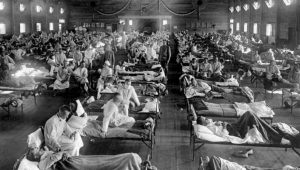 Earlier this month, the New York Times reported on a recent study that predicts the effects of global warming on viruses moving between various species of mammals over the next 50 years.
Earlier this month, the New York Times reported on a recent study that predicts the effects of global warming on viruses moving between various species of mammals over the next 50 years.
According to the article, “The shuffling of viruses among animals may increase the risk that one will jump into humans and cause a new pandemic, the researchers said. Scientists have long warned that a warming planet may increase the burden of diseases.”
That may not be what we want to hear while the current pandemic remains in view, but two studies by scientists released in February assert that “Covid arose through a similar sequence of events, with coronavirus jumping from bats to wild animals,” the New York Times article states.
Predictions of the future are never rendered with a guarantee, which is why exploring the past can offer a more solid, yet still somewhat inconclusive, theoretical outlook. Hindsight is an advantage but not a certainty. So, with that in mind, let’s return to the 1918 influenza pandemic for a moment and examine some of the conditions that may have birthed it.
Santa Fe, Kansas is identified as the possible ground zero for the 1918 pandemic. In 2018, the Wichita Eagle described the Santa Fe location as part of the Kansas prairie “where dirt-poor farm families struggled to do daily chores—slopping pigs, feeding cattle, horses, and chickens, living in primitive, cramped, uninsulated quarters.” It added, “It’s not known whether it started in the pigs or chickens or birds flying overhead. But it spread to young farmers…”
As for climate change a century ago, the Inside Climate News website reported in 2019 that “Global warming has been fueling droughts since the early 20th Century, when soils started drying out at the same time across parts of North and Central America, Eurasia, Australia and the Mediterranean, new research shows.” While other factors like El Nino had contributed to droughts in the U.S. Southwest, “in the first half of the 20th Century, something different was starting to happen. Soil moisture decreased across all those areas at the same time—a nearly unmistakable sign that it was driven by rising global temperatures…”
The Slate website last year referenced an article in the March 1912 issue of Popular Mechanics that discussed evidence of global warming, noting that “a graph illustrated how temperatures in 1911 had been beaten in each month but November. It’s the sort of reporting we’re all too used to today—but this was 1912.”
Effects of the Industrial Revolution were already playing a role in global warming. The science.org website explains that “soot from industry drove early 20th century warming as it drifted into the Arctic, darkening snow and absorbing sunlight.”
Such environmental conditions affect the migration of species to cooler locations, thereby reshaping the ecosystem. The Kansas farms, with their “cramped, uninsulated quarters” may have facilitated the means by which, as the New York Times notes, “different species come into contact for the first time” so that “viruses may be able to infect new hosts.”
So, what might possibly account for the decrease in such pandemics throughout the middle of the 20th century? According to the Inside Climate News website, “The distinctive regional patterns of drying linked with global warming disappeared from about 1950 to about 1975, when they likely were masked by another force that can affect the climate: massive emissions of industrial aerosols from coal-burning, cars and trucks, cement production and construction…Aerosols can cool the atmosphere and affect cloud formation, rainfall and temperatures.”
In the end, however, uncertainty is still a factor. After all, as the Frontiers in Earth Science website explains, “The warming observed in the early 20th century (1910–1940) is one of the most intriguing and less understood climate anomalies of the 20th century.”










